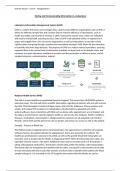Osman Yousuf – Unit 4 – Assignment 4
Storing and Communicating Information in a Laboratory
Laboratory Information Management System (LIMS)
LIMS is a system that stores and manages data, used by many different organisations such as NHS. It
allows for effective sample flow and contains data to improve efficiency of laboratories, such as
health and safety, and records of training. In LIMS, instruments may be used, which are calibrated,
and used by trained staff, ensuring accuracy. Data of LIMS is all uploaded online, as opposed to in
paper and tangible form, this can ensure organisation as well as being able to access the certain
rapidly rather than going through countless documentation on paper. LIMS allows for the extraction
of scientific data from large datasets. The purpose of LIMS is to reduce manual operations, ensuring
organised flow in the normal tasks conducted by scientists, to keep track on all samples, tests, and
inventory to ensure laboratory workflow is constant and the prevention of delays or issues, and of
samples being lost, contaminated or expired.
National Health Service (NHS)
The NHS is a main healthcare organisation based in England. This means their LIMS/APEX system is
extremely large. The NHS will retain scientific information regarding all patients who are with and use
the NHS. This information includes full legal names, date of birth, Addresses, Phone numbers and
emails, and Unique NHS numbers for individuation. All information is uploaded onto LIMS
system/software. Every interaction with NHS such as phone calls, appointments are all tracked, and
the data is stored onto the specific patients’ profile as well as onto the database. Health conditions,
diseases, medications, immunisations, allergies/adverse reactions are all uploaded onto Medical
Records, which both specific personnel such as doctors and nurses can access as well as the patient.
Example - Process of Blood Test
The Patient books an appointment to have blood taken, the appointment is stored by GP surgeries
software/system, the patient attends the appointment, this is also stored by the institute. The
healthcare professional is named and recorded, as well as the specific blood test being taken are
recorded, such as purple tube for HbA1C in diagnosing T2DM. When the blood has been taken, it is
uploaded onto the system, with dates. Additional notes may be recorded such as if the patient is
taking anticoagulant medications. The blood is stored safely within the facility, until transportation.
The bloods that are transported are labelled with the dates, and specific codes/numbers to be able
to track the blood and return back after analysis, and to be able to identify which patient the blood
sample belongs to. It is recorded on the GP Surgeries own system that the bloods are out for
, Osman Yousuf – Unit 4 – Assignment 4
transportation to a laboratory for analysis. At the laboratory, the blood will be either scanned or
recorded another way and uploaded onto the system to show it has been received. Date and timings
of analysis is recorded, the findings are immediately recorded electronically, or equipment
generated. The laboratory can also make additional comments on the findings, the laboratory stores
the data of their findings, which is transferred to the GP surgery. The GP Surgery records that the
results have been analysed, returned back, and received. The GP then reviews the findings the
laboratory have discovered, in which the GP determines if normal, or abnormal by comparing results
to normal reference ranges. The results from the lab, and comments from either the Lab or GP
regarding specific test results are immediately uploaded onto the patients medical records, as well as
the Surgery’s software/system. Another appointment is arranged, and recorded, where the
healthcare professional discusses the results to the patient.
Biomedical Informatics with the data associated, are only
reported to those deemed necessary, such as General
Practitioners, Nurses, Physicians. It is the duty of healthcare
professionals to abide by the laws of data protection, and
always maintain patient confidentiality.
When the right results are given to the correct patient, it
means the LIMS system has been followed correctly, ensuring
smooth sample flow, and making its way back to origin.
Sharing Information to Different Departments
NHS Laboratories can share Brief
patient data such as name, NHS
number, and sometimes depending on
the test additional comments such as
ethnic origin. NHS Labs can exchange information via National Pathology Exchange (NPEx) where all
labs connect to a single hub, allowing test requests, and pathology results to be sent to another
laboratory digitally and rapidly. The pathology LIMS system can send test results through Message
Exchange for Social Care and Health (MESH), which then goes to the requestor of a healthcare
worker in primary or secondary care settings. MESH is used for both sending and receiving.
Reasonings for Sharing Information/Communication
- Ensuring the best interests for the patient/individual by quality control, ensuring the results
are consistent and accurate when testing samples. Information/results may be sent to other
labs for confirmation of results.
- Complex or rare tests sometimes require going to specialist labs for complete testing.
Therefore, information is sent to the specialist labs.
- In general, labs will need to communicate with external regulatory bodies to ensure all legal
and health and safety requirements are met
- Communication with general councils/bodies/institutes who set the standards of working. If
a worker breaches these standards, they can be reported for investigation.




